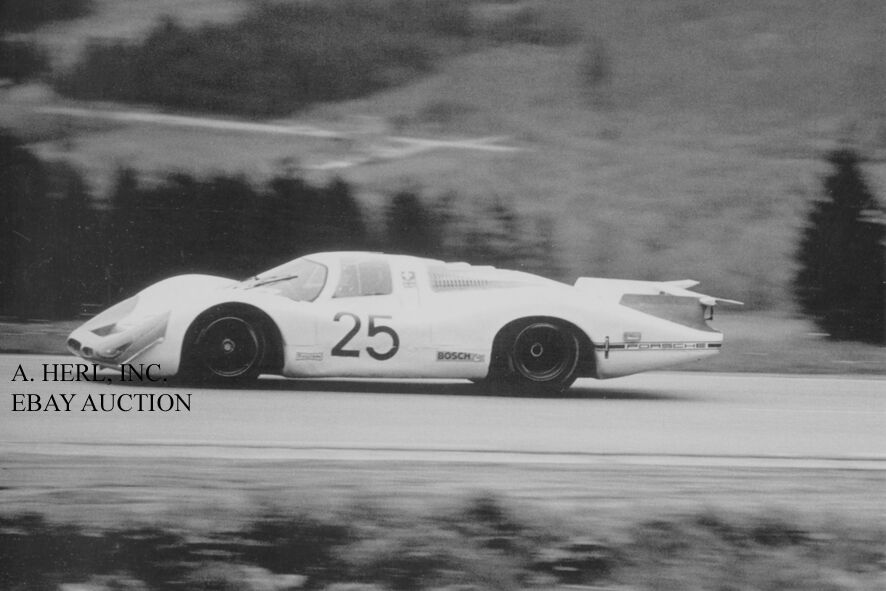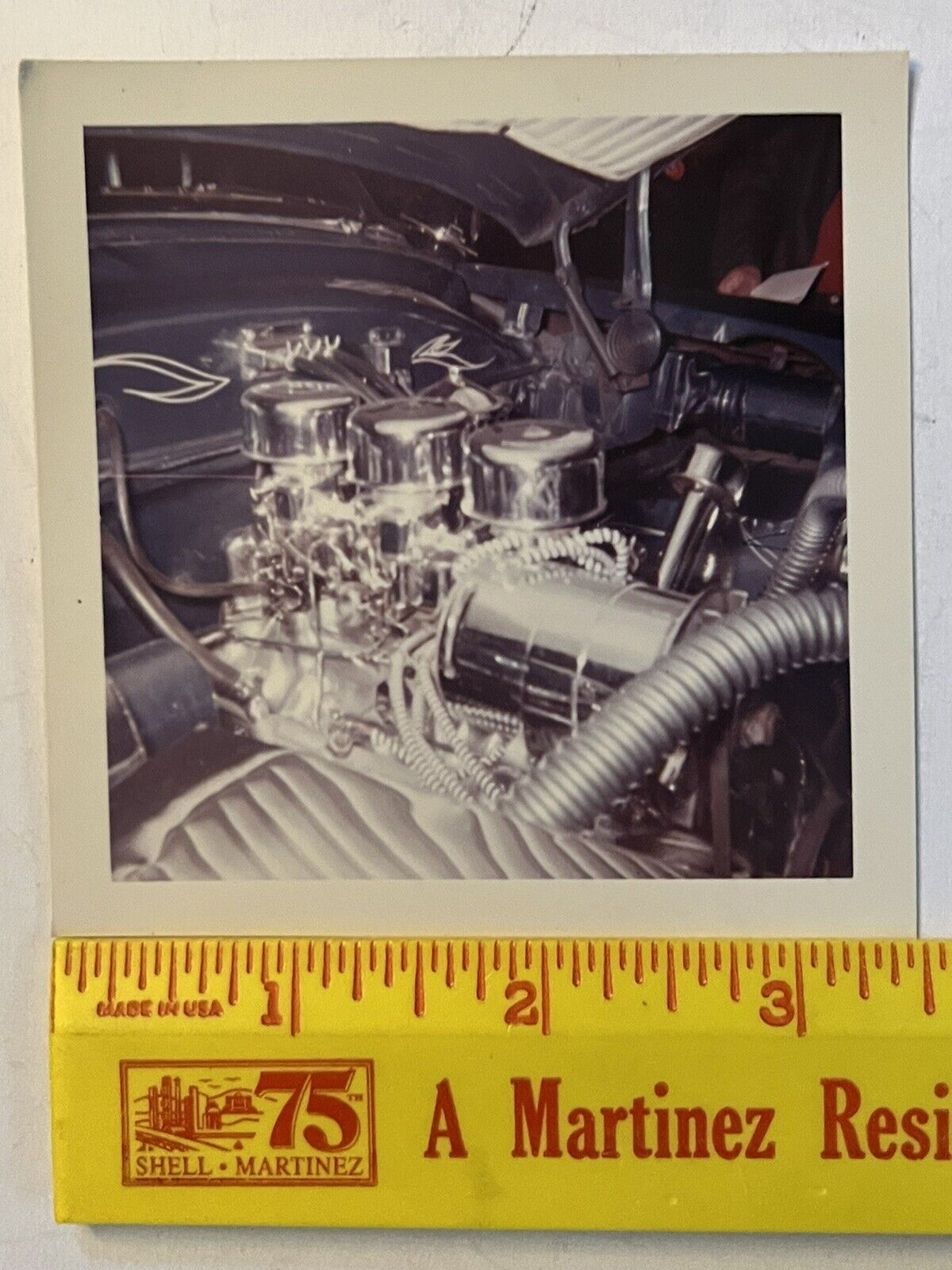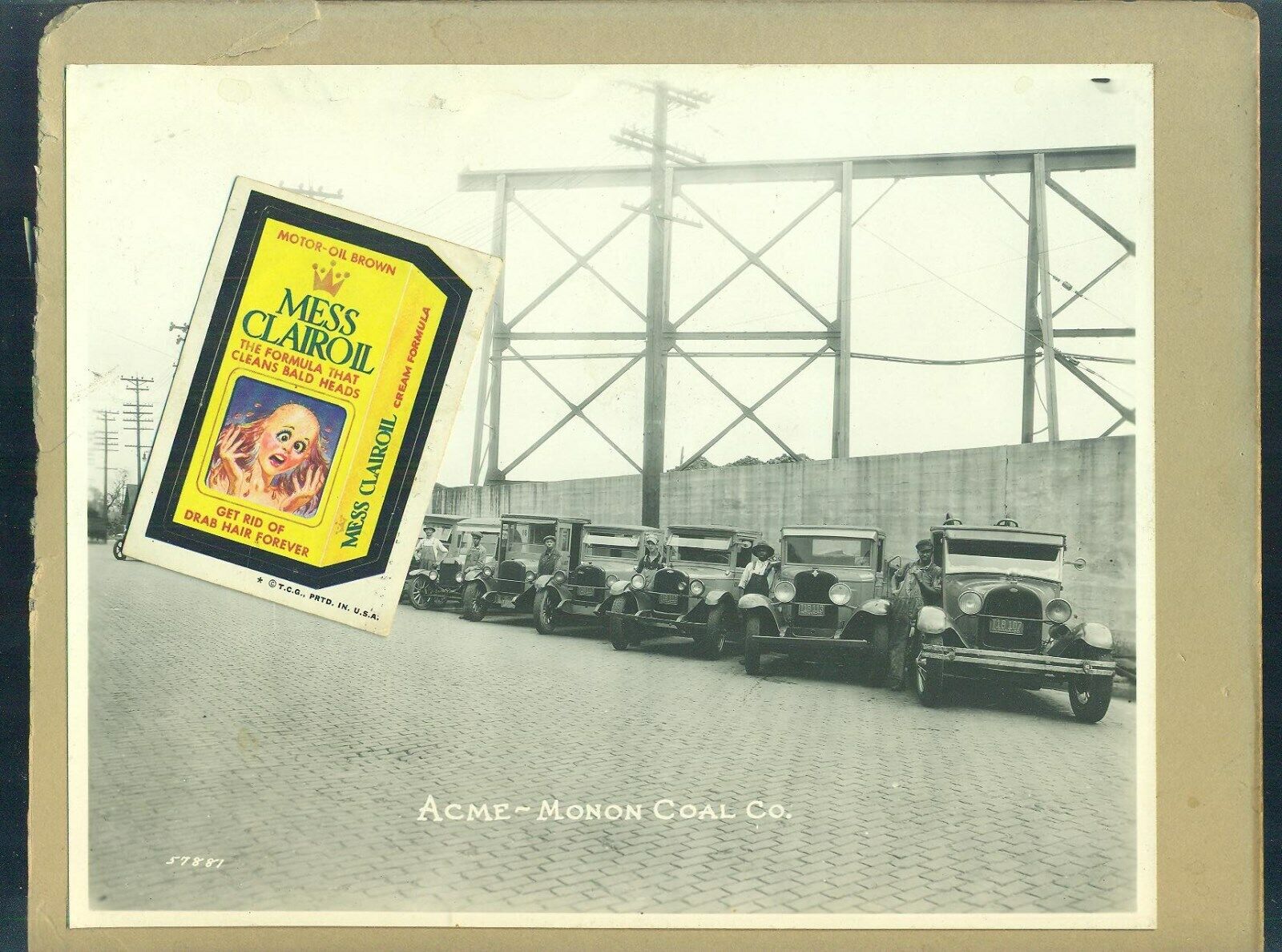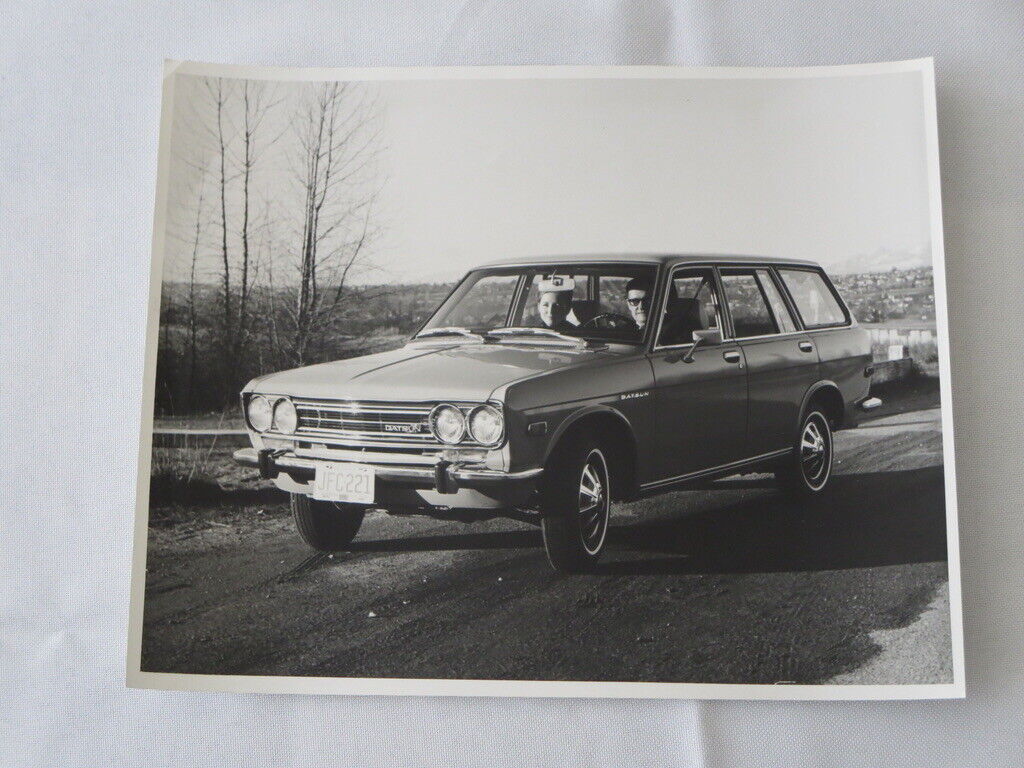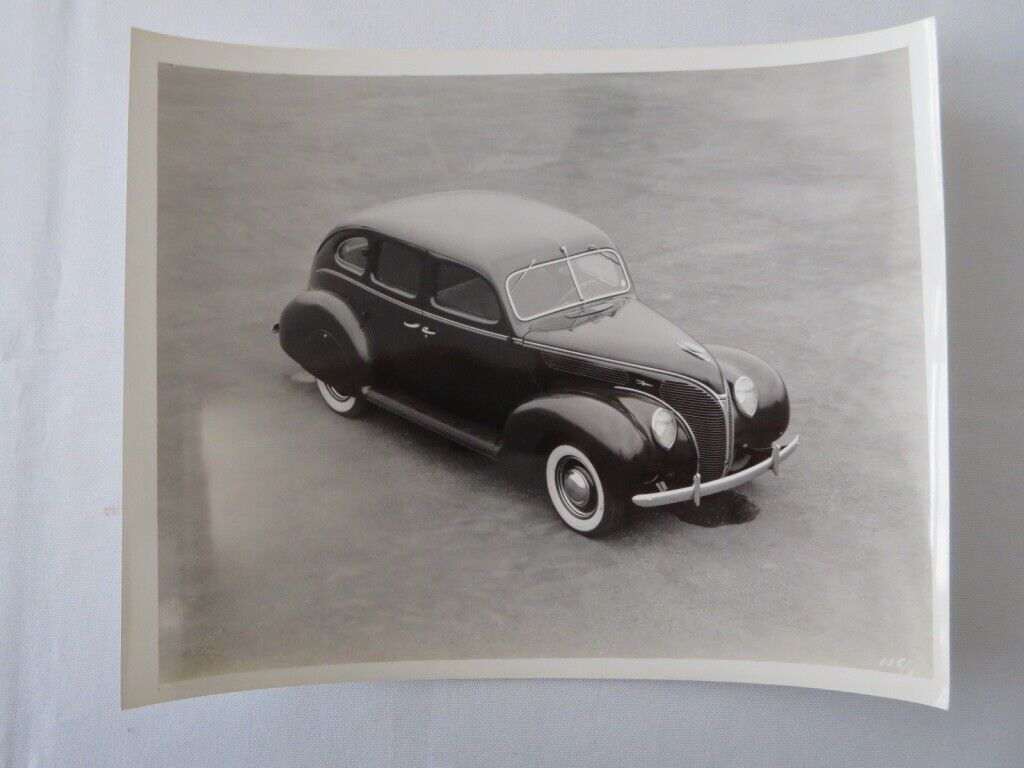-40%
Porsche 908 & Siffert & Redman - winners 1000km of Spa Francorchamps 1969 photo
$ 5.14
- Description
- Size Guide
Description
WEARE
CLEARING OUT OUR ARCHIVES!
A superb and rare photo taken during the
1969
edition of the
1000km endurance roadrace of Spa - Francorchamps
in
Belgium
. Shown in this great image is the factory
Porsche 908 LH
(number 25) of the
winners Joseph Siffert (
Switzerland
) and Brian Redman (
England
)
. The magnificent duo needed a time of
4:24:
19.600 to complete the
1000 km
(
621 mi
) long race. The shown car was inscribed for the race by
Porsche System Engineering
, the official Porsche factory racing team.
The
Porsche 908
was a racing car from Porsche, introduced in 1968 to continue the Porsche 906/Porsche 907/Porsche 910 series of models designed under Ferdinand Piech. As the FIA had announced in 1967 to change the rules for the World Championship for Marques by limiting the displacement of prototypes to 3000 cc, as in Formula One, Porsche designed the new 908 as the first Porsche sports car to have an engine with the maximum size allowed. The previous Porsche 907 only had a 2200 cc flat-8 engine with 270 hp. The new
3 litre
Flat-8 engine produced initially 257 kW (350 hp) at 8400 rpm, as well as some teething problems. Also, being traditionally air-cooled and with only 2 valves per cylinder, it was still down on power compared to more modern F1 designs which delivered over 400 hp (300 kW), but were not suited to last in endurance races. The 908 originally was a closed coupe to provide low drag at fast tracks, but from 1969 on was mainly raced as lighter open spyder named 908/2. In 1970 and
1971, a
more compact 908/3 was intended to complement the heavy Porsche 917 on twisty tracks tracks that favored nimble cars, like Targa Florio and Nürburgring. Sold off to privateers for 1972, various 908 were entered until the early 1980s, often retro-fitted with Porsche 934-based
2.1 litre
turbo engines. Despite winning the 1000km Nürburgring, the 908 was anything but convincing in 1968. The older and smaller 2200 cc 907 had started the season with dominating wins and later delivered better results than Porsche's first serious attempt in the top prototype category. Meanwhile, old 4.7-litre Ford GT40 were winning several races on the faster tracks, with the Ford P68 being a failure, Ferrari remaining absent, and the Alfa 33 still with 2000cc. As sports cars with up to 5000 cc would be allowed in 1969 if at least 25 (compared to
50 in
1968) of them had been produced, Porsche decided to go one step further and build the required 25 cars for the 5000 cc sports car category - the new Porsche 917. This risky investment should take about a year, though, and the 908 was supposed to deliver results in the meantime. The 1968 24 Hours of Le Mans were postponed from June to end of September due to political unrest in France, setting up the stage for a showdown between the 908s and the GT40s. For the first time, these Porsche 908 LH Long Tails were the fastest in qualifying and the early stages of the race, but it showed that Porsche had not taken advantage of the additional time to improve the 908. Troubles with the alternator caused delays and even disqualifications as the new Porsche team leaders had misinterpreted the repair rules. Once again, a V8-powered Ford won, a 907 Long Tail came in second in front of the sole surviving
908. In
addition, Ford had again taken the World Sportscar Championship, too. For 1969, the prototype rules were changed, and Porsche lowered the weight of the 908/02 spyder by
100 kg
(
220 lb
), removing the roof and the long tails. Aluminium tube frames were used, with air pressure gauges to check them. The 1969 24 Hours of Daytona were a disaster for Porsche, as all three 908/02 failed, and two Lola T70 won. At the 12 Hours of Sebring, a Ford GT40 and the new Ferrari 312P Prototype was faster. At that time, the more powerful Porsche 917 was introduced in
Geneva
, and it seemed that the career of the 908 was now over. But with the big brother having arrived, the 908 started to succeed. The next race was the BOAC 500 at Brands Hatch, were the 908 finally were successful, winning
1-2-3
. With additional wins at the 1000km Monza, the Targa Florio, the 1000km Spa and an overwhelming 1-2-3-4-5 at the 1000km Nürburgring, the 1969 World Sportscar Championship season was secured by the 908/02, while the Porsche 917 had teething problems. On the other hand, the all-important 24 hours of
Le Mans
were again won by a Ford GT40 in 1969, as the 917s had gearbox troubles after leading for many hours. Yet, a 908 challenged for the win, as Hans Herrmann came in as a very close 2nd behind Jacky Ickx. Herrmann's 908 low drag coupé was fast on the straights, but near the race end the brake pads wore down, indicated by a light that was introduced with the 908s. The team gambled on not changing the pads, which allowed Ickx to pass under braking. Despite the more powerful 917 getting better towards the end of 1969, the career of the 908 would continue. On rather twisty and slow tracks like Nürburgring and Targa Florio, the 917 was not suited well even after being modified to the "917K". So rather than trying to make "one size fit all", Porsche built dedicated cars for each type of racing track. Based upon the lightweight and short Porsche 909 which was used in hillclimbing, the new open cockpit version named 908/3 was an even shorter spyder than the 908/2. In 1970 and 1971, this version was entered successfully in the
1000 km
and the Targa, where typical speeds were only about half of the
240 mph
(
390 km/h
) which the 917LH long tails could achieve at
Le Mans
. With the combination of the powerful 917 and the lightweight 908, Porsche dominated the championships from 1969 until 1971. The 908/02 in which Steve McQueen finished second at the 1970 12 Hours of Sebring was also used as a camera car for the
Le Mans
(film) in the race itself. Steve McQueen was not allowed to drive a Porsche 917, though. In 1971, fins were added to the 908 which were now outpaced at the Targa by two Alfa Romeo Tipo 33. All entered 908s crashed, but Vic Elford had managed to set fastest lap. The next race at the 'Ring saw a 1-2-3 of the
908 in
front of two Alfas, but with Alfa scoring wins in Brands Hatch and at Watkins Glen, it was proven that these prototypes could even beat the 917s. For 1972, the 5000 cc loop hole rule was discontinued, and the 917 as well as its main rival Ferrari 512 became obsolete. In the 3000cc prototype category, Porsche's main advantage was the low weight, as the engine was underpowered with 370 hp (280 kW). The new rules required a much higher weight (
650 kg
(1,400 lb)) than Porsche could achieve (well under
600 kg
(1,300 lb)), giving the advantage to Ferrari 312PB, Alfa Romeo T33TT and Matra with their more powerful F1-derived engines that had 420 hp (310 kW) or more even in endurance trim. Porsche decided to discontinue the 20 year old history of factory racing and sold the 908/03 cars to customers. Besides developing the 917/10 turbo for CanAm, Zuffenhausen focused on the development of the already aging Porsche 911, testing the 911 flat-6 with turbochargers. Yet, a Porsche 908LH Coupé was entered by Reinhold Joest in the 1972 24 Hours of
Le Mans
, finishing a strong 3rd with the 3 year old car. Customers continued to race several 908/3, fitted with extra weight as required by the rules. In 1975, some 908 were fitted with turbo-engines, similar to the one used in the Porsche 934. Even with
2.1 litre
and a turbo factor of 1.4, the turbos by now outpowered normally aspirated
3 litre
engines. Taking advantage of that, the factory developed a new spyder, the Porsche 936 of 1976. Unlike the 934 and 935, they did not offer the 936 for sale, entering it in a few races only, mostly at
Le Mans
. Several customer-908s were upgraded with 936-style bodywork. The Porsche 908/80 Turbo of Joest and Jacky Ickx which finished 2nd in the 1980 24 Hours of Le Mans turned out later to have a real Porsche 936 chassis, though. The 908 has won the 1000km Nürburgring in three decades, four years in a row from 1968 to 1971, and again in 1980, now with Turbo-Power. Porsche 908s were still run competitively in
1982, a
remarkable feat for a car that was introduced in 1968 and at that time intended to become obsolete after 1969! 908s are still raced today in eg. the Classic Endurance Racing (CER) series.
Professor
Ferdinand Porsche
initially started the company called "Dr. ing. h. c. F.
Porsche
GmbH" in 1931, with main offices at Königstrasse in the center of
Stuttgart
. The company offered motor vehicle development work and consulting, and did not initially build any cars under its own name. One of the first assignments the new company received was from the German government to design a car for the people, a "Volkswagen" in German. The first Porsche, the Porsche 64, was developed in 1939 using many components from the Volkswagen Beetle. After World War II, Ferdinand Porsche's son, Ferry Porsche, decided to build his own car because he could not find an existing car that he would be interested in buying. The first models of what was to become the 356 were built in a small sawmill in
Gmünd
,
Austria
and had aluminum bodywork: the modern Porsche company was born. The prototype car was shown to German auto dealers, and when pre-orders reached a set threshold, production was begun. Many regard the 356 as the first Porsche simply because it was the first model sold by the fledgling company. Porsche commissioned Zuffenhausen-based company Reutter Carosseri, which had previously collaborated with Porsche on Volkswagen Beetle prototypes, to produce the 356's steel body. Porsche constructed an assembly plant across the street from Reutter Carosseri; that assembly plant is now known as Porschestrasse. The 356 was road certified in 1948. Not long afterwards, on
January 30, 1951
, Ferdinand Porsche died from complications following a stroke. In post-war
Germany
parts were generally in short supply, so the 356 automobile used components from the Volkswagen Beetle including its engine, gearbox, and suspension. The 356, however, had several evolutionary stages, A, B, and C, while in production and many VW parts were replaced by Porsche-made parts. The last 356s were powered by entirely Porsche-designed engines. The sleek bodywork was designed by Erwin Komenda who also had designed the body of the Beetle. Porsche's signature designs have, from the beginning, featured air-cooled rear-engine configurations (like the Beetle), rare for other car manufacturers, but producing automobiles that are very well balanced. In 1964, after some success in motor-racing, namely with the Porsche 550 Spyder, the company launched the Porsche 911 another air-cooled, rear-engined sports car, this time with a 6-cylinder "boxer" engine. The team to lay out the body shell design was led by Ferry Porsche's eldest son, Ferdinand Alexander Porsche (F. A.). The design phase for the 911 caused internal problems with Erwin Komenda who led the body design department until then. F. A. Porsche complained Komenda made changes to the design not being approved by him. Company leader Ferry Porsche took his son's drawings to neighbouring body shell manufacturer Reuter bringing the design to the 1963 state. Reuter's workshop was later acquired by Porsche (so-called Werk II). Afterward Reuter became a seat manufacturer, today known as Keiper-Recaro.
This is a very nice and very rare photo that reflects a wonderful era of Porsche ‘s automotive history in a wonderful way.
This is your rare chance to own this photo, therefore it is printed in a nice large format of ca. 8" x 12" (ca. 20 x
30 cm
).
It makes it perfectly suitable for framing.
Shipping costs will only be $ 7.00 regardless of how many photos you buy. For 5 or more photos, shipping is free!
(Note: A. Herl, Inc. does not appear on photo, for ebay purposes only)
No copyright expressed or implied. Sold as collectable item only. We are clearing out our archives that we have gathered from various sources.
All items always sent well protected in PVC clear files
and board backed envelopes.
We have photographs that came from professional collections and/or were bought from the original photographer or press studio! They are all of professional and excellent quality.
After many decades of professionally collecting photographs and posters we are clearing out our archives. They make the perfect gift and are perfectly suited for framing. They will look gorgeous unframed and will be a true asset nicely framed with a border. They are a gorgeous and great asset in every home, workshop, workplace, restaurant, bar or club!
First come - first served. And you can always contact us for your requests. Please ask any questions before the auction ends.
